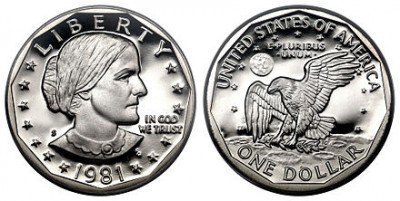The Susan B. Anthony Coin – Why Did SBA Dollar Coins Fail?
On October 10, 1978, Susan B. Anthony coin legislation was approved, and the first circulating coin honoring the women’s rights pioneer was on its way to production. The Susan B. Anthony dollar represented a downsizing of the dollar coin.
In 1978, when the “Susie B” was approved, the much larger Eisenhower dollar was in its last year of production. Measuring 38.1 millimeters wide and weighing 22.68 grams (copper-nickel version), the Eisenhower dollar was virtually as large as the old silver dollars from early in the 20th century.
The Susan B. Anthony coin was supposed to make transactions easy. Its 26.5-millimeter diameter was distinct from other U.S. denominations (though perhaps too close to the width of the quarter – more on that issue in a moment). The 11-sided rim of the 8.1-gram Susan B. Anthony coin was also unique from other circulating coinage. Finally, the design of the coin was special.
Clearly, it would be the only contemporary coin to bear the likeness of a female – something that hadn’t been the case in decades, since the times when Miss Liberty was a staple on coinage. The important difference in that regard, of course, is that Susan B. Anthony was a real person, whereas Lady Liberty is symbolic. As was the case with the preceding Eisenhower dollar, U.S. Mint Chief Engraver Frank Gasparro designed the Susan B. Anthony dollar coin. In fact, the reverse of the SBA dollar features the same design as the reverse image from the Eisenhower dollar coin -- the Apollo 11 insignia.
Why The Susan B. Anthony Coin Fell Out of Favor
So, why did Susan B. Anthony dollars fail to circulate? At least two key factors owe to the demise of the Susan B. Anthony dollar. One was the coin’s size. Made from cupro nickel, the Susan B. Anthony dollar looked too much like the quarter – in fact, the Susie B is just 2.2 millimeters wider than the modern-day quarter. On quick glance to the typical non-numismatist, the two coins have many seeming design similarities.
Another problem that plagued Susan B. Anthony dollars early on is the fact that the dollar bill was still circulating concurrently with the dollar coin. This is the same reason more recent efforts to circulate the Sacagawea and Presidential dollar coins have also failed.
Following a huge production of some 760 million pieces in 1979, the U.S. Mint stepped back mintage of Susan B. Anthony dollars in 1980, striking only about 90 million dollar coins that year. In 1981, the last year of the original SBA dollar run, just 10 million business strikes were made – all for inclusion in coin collector sets only.
In 1999, the U.S. Mint would strike a little more than 41 million Susan B. Anthony dollar coins to meet commerce demands; in the 1990s, the dollar coin was in use again, with millions of SBA dollars being distributed as change in United States Postal Service stamp vending machines. Sacagawea dollar coins would go into production in 2000.
Susan B. Anthony Coin Values
Susan B. Anthony dollar coins are generally worth a little more than face value in uncirculated grades. 1979, 1980, and 1999 business strikes are worth $2 in brilliant uncirculated grades. 1981 Susan B. Anthony dollars are worth $3.50 in the same condition.
All 1980 and Type I Susan B. Anthony dollar proofs are valued at $8. 1979 Type II dollar proofs, which feature a clearer “S” mintmark than their Type I counterparts, are worth $125. The 1981-S Type II proof dollar sells for $250. The 1999-P proof Susan B. Anthony coin goes for $15.
The 1979 “near date” Susan B. Anthony dollar coin has a value of $20 in uncirculated grades.

